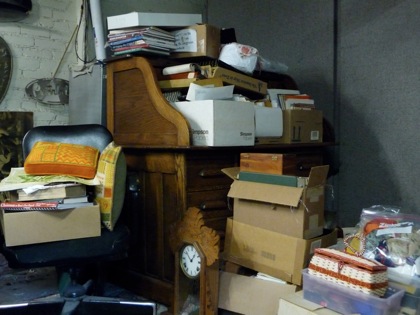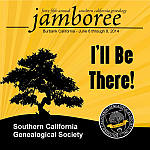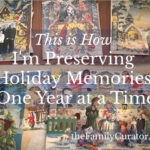A few people have asked me to share how I am working through the boxes from my aunt’s estate. I wish I had a magic wand to make the entire project easier and less daunting, but each unique situation seems to call for reworking and refining the process. What is working for me with this estate may not work for you, but I hope it will give you some ideas and encouragement for your own inherited archive.

This is what happens when you have to clear out a relative’s home quickly.
The Stuff moves home with you. Here’s Uncle Benny’s pastor’s desk and
Auntie’s sewing box with the boxes brought home from her house.
The MOST IMPORTANT lesson I’ve learned is to ask youself, What is my main goal?
I tend to get easily distracted, and probably need to print the answer in large type and put in front of me on the work table. I forget that my goal is NOT to:
- Open a vintage sewing notions shop on Etsy
- Become an antique vendor at the local swap meet
- Become a five-star eBay seller
- Display a china teacup collection or Southwest art in my home.
Instead, I have to remember to focus on a workable goal for me, today.
My Archive Goal
• Collect and preserve MY family history — photos, letters, and documents from previous generations
• Collect and preserve OTHER family history — items from other families that could be returned
• Collect and preserve LOCAL history — photos, items, ephemera that tell the story of the community and could be donated to the local historical society
Staying focused on the goal is my greatest challenge in working with an estate.
When I inherited my grandmother’s trunk, the contents had already been sifted so many times that everything left had value to our family history. With my aunt’s estate, the opposite is true. Auntie carefully preserved everything, from her grade school report cards to the first rose presented by her future husband. What to save? What to toss? My aunt and uncle had no children, but it seems callous to just throw away these things that were once so important to someone I loved. So, I stop and read a few notes (who, what, when, why) and something shifts in my understanding of that young girl in 1954. Maybe all these little collections and scrapbooks and tidbits were never intended so much to be immortalized and saved, as they were her own way of trying to make sense of her feelings and the events in her life. It’s certainly a time-travel snapshot of her life. If I were writing a biography of my aunt’s life or even a novel, these boxes would be a research dream come true. But, I’m not (at least, I don’t think I am, today).
This past weekend I spent several hours working through boxes. You can see from the Before photo that I have several boxes overflowing with papers and things.
My basic method was to go through the contents of each box at a large worktable to gauge the overall scope of the collection.
Collection Overview
• 12 High school and college yearbooks
• Packet of school report cards, grades 3-12
• Packet of letters from young man in Texas
• Loose letters and cards from family and friends all over the world
• Church records, visiting books, tracts, etc.
• School district employee directories 1975-1991
• 1 box of congratulation cards and mementoes from high school graduation
• 1 box of congratulation cards and mementoes from college graduation
• 1 large stationery box vintage shower cards
• 1 large vintage candy box with cards and dried flowers
• 3 photo albums• 2 notebook diaries from my uncle before and after his heart surgery
• 1 large box loose vacation photos, mostly scenery; film developing envelopes
• Wall calendars from 1958 to present, each date filled in diary-style
• Pocket calendars from 1975 to present
• Household files
• Employment contracts, paystubs, manuals
• Two address books
• 15 Bibles with personal notes on end papers and margins
• Large box of craft and quilting patterns
• Scattered vintage office supplies
• Vintage blank greeting cards
Now that I have an idea of the kind of material my aunt saved, I am working out an overall plan:
Next Steps
My goal is to collect and preserve family history and local history material, however, I really do like a lot of the vintage ephemera Auntie saved over the years, so I am giving myself permission to save some of the best for my own craft projects!
1. Contact local historical society about donating high school memorabilia, church records, school district directories.
2. Contact college about donating yearbooks and other mementos. Alternate: donate yearbooks to e-yearbooks.com for scanning.
3. Sort vacation photos; save a few with people; discard scenery.
4. Donate craft patterns to thrift shop.
5. Save best vintage cards for my projects.
6. Go through high school, college boxes; save diplomas to scan.
7. Collect vitals; birth, marriage, certificates, obits from newspapers, old funeral programs.
8. Save packet of letters from Texas boy; possible return to family?
9. Remove best photos from magnetic album
10. Save address books
11. Bibles?
Throw Away/Give Away
Misc. Correspondance
Magnetic photo album (scan pages, remove best photos)
Old calendars
Old greeting cards
Vintage office supplies
Old home insurance policies
Property purchase and sale records (keep Bill of Sale with address)
Employee records (keep salary record)
Teacher cards from students
At the end of the day I had filled two large Recycle Bins with paper trash, and was left with six boxes —
After
Vitals and Family History – keep
Photos – keep
Vintage – keep for projects
High School, Church History (Bibles) and Local History – donate?
College – donate?
Orphan Letters – research and return
Working through my aunt’s things has been much more difficult than I expected. She was a very private person, and I think that many of the things she preserved were truly for “her eyes only.” I also know that she would never want to create a burden for her family. I’m comfortable sharing the more public memorabilia she collected by donating it to the historical society or preserving it in my own Family Archive, but other things I’ve decided to respectfully destroy in honor of her privacy.
Some people may disagree with this arrangement; they might argue that anything and everything is public property after someone dies. I suppose it’s a good lesson to all of us about the things we choose to keep or discard. One never knows who might read those letters or diaries or where they might finally come to rest.






What a big job! I immediately wondered what you were going to do with the calendars. That's an awful lot of scanning, but I guess it depends on how interesting you find the daily notes. I like the idea of returning old letters 🙂
Yep, Myrt. You're right. Those address books might be useful, and they don't take up much space. They stay! But what about 50 years of wall calendars with every day a diary? That's a good size box? Scan?
This obviously took a lot of thought. It's hard to pare down. All I can say is I am thankful for scanners so most items can be preserved.
I wouldn't throw out address books, but that just me.
Myrt 🙂